We apply Cookies to continuously optimize your experience in website browsing, analyze website visitor volume, create personalized content and digital advertising, respect and strive to protect your right of privacy.
The act of your proceeding to use our website signifies the fact that you have agreed To our using Cookies.
Art Collection
The Grand Hi Lai Hotel has a collection of more than three thousand artworks in total. More than twenty artworks are selected and exhibited in front of the public. These artworks are distributed on different floors of the hotel. Witnessing these valuable authentic artworks, people will be totally indulged in the corridor of time and space.
-
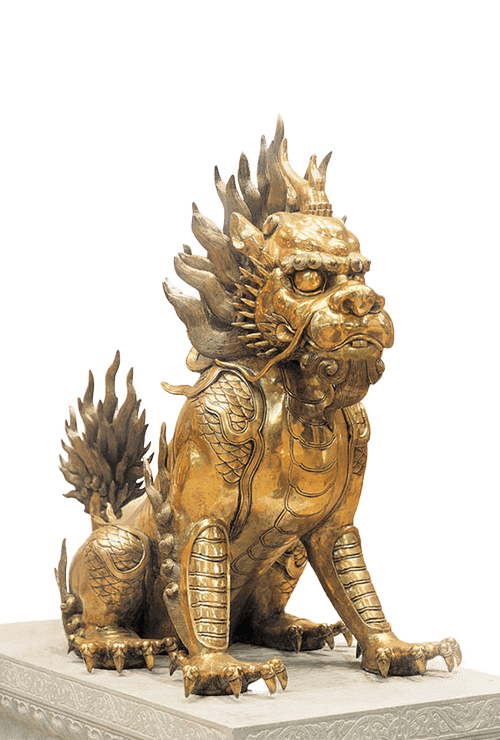
1901-2000AD
Tianyimen Gold-Coating Chi-Lin
-
Author:unknownType of work:Cooper
-
Source of Artwork:EasternExhibition Inside the Hotel:Lobby
-
Value:
The Chi-Lin (a fabulous animal appearing only in times of peace and prosperity) statues are treasures of the area of Grand Hi-Lai Hotel as well as a spiritual symbol for the hotel. The statues are made by copying the statues of a mythical animal in front of Tianyimen in the Forbidden City. The statues are also coated with gold. The mythical animal called Shiehzhih is a loyal divine beast which is, in legend, supposed to be good at telling right from the wrong and also making remarkable judgments. The royal garden located in the north of the Forbidden City is the Imperial Garden which offers an area for emperors, empresses and concubines to stroll around every day. Gold-coating technique: a mixture of gold and mercury is coated on the surface of bronze utensils. Then, the objects are heated in order to let mercury sublimat. Gold can adhere to the utensils’ surface and cannot fall off. This technique is like the modern gold-plating method. The technique had actually appeared during the Epoch of Spring and Autumn (770-403 B.C.) and the Epoch of Warring States (403-221 B.C.) In the Chi-Lin statues, their bodies and four limbs are covere with helmets and armour. Having wide-open noses and mouths, they had ferocious eye contact. They are decorated with the patterns of numerous Chinese characters (wan) each of which has a flowery rhomboid shape. The rest of the patterns are reliefs of numerous cloud shapes. These paterns are repeatedly and continously presented by the use of varieties of concave and convex. Thus, these above elements make the statues look dignified and magnificent. -
-
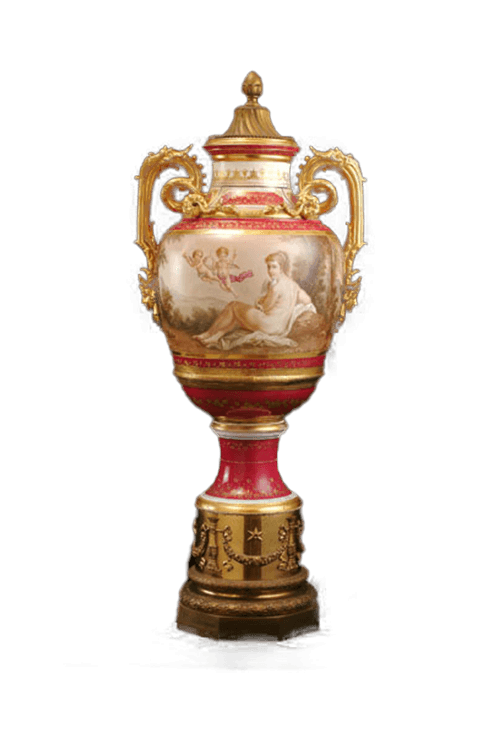
1601-1700 AD
Golden Double-Ear Western Porcelain Vase
-
Author:unknownType of work:Porcelain
-
Source of Artwork:WesternExhibition Inside the Hotel:Lobby
-
Value:
Featuring the ornaments and color paintings in French neo-classic style, this porcelain vase is the work of the 1700s. The figures on the work are the goddess of the moon, Diana, and the god of love, Cupid, depicted with the balanced lines and soft contours. -
-
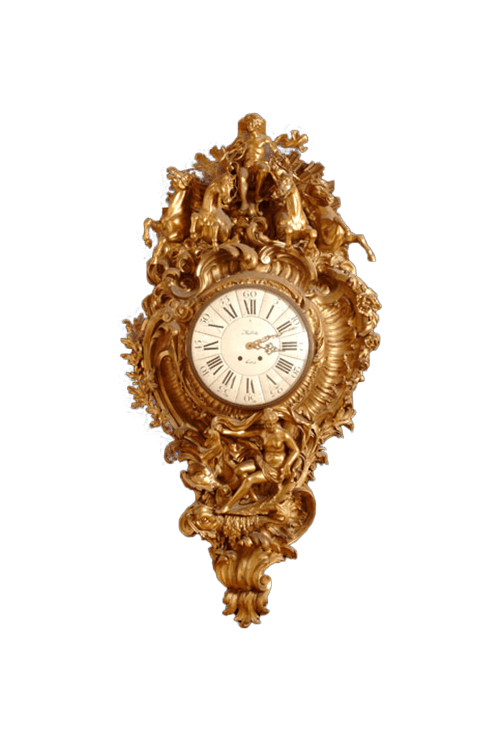
Bronze Cartel Clock
Bronze Cartel Clock
-
Author:UnknownType of work:Furniture
-
Source of Artwork:WesternExhibition Inside the Hotel:Lobby
-
Value:
In the middle of the eighteenth century, French clockmakers started giving up wood and using bronze. In design, the clock’s material of carving sculpture and main body is gold-plated bronze. Roman numerals made of pottery and porcelain are made by high-temperature glazing. Above the clock, there is a carriage with the god of the sun, Apollo, controlling four horses. Below it is the goddess of the moon, Diana, riding a dolphin. In the middle section are curly flower decorations winding round the whole face of the clock. Carved flowers, unbalanced design, whirl-like veins etc. – all these are in the Rococo style. -
-
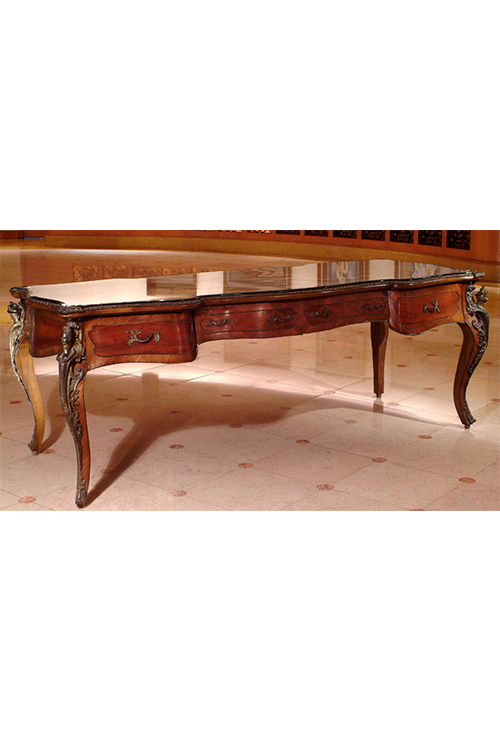
Large Classic Table
Large Classic Table
-
Author:UnknownType of work:Furniture
-
Source of Artwork:WesternExhibition Inside the Hotel:Lobby
-
Value:
A soft curved appearance is characteristic of Rococo. Made of heart of walnut wood, the table has curved and spiral-whirled pillar bases. The table is decorated with gold plate and gold leaf. With large curved circles, the whole part from the top of the table to the table feet has frame structure casted with rococo-style bronzes. Two kinds of wood are used to make the top of the table. The table feet are regarded as a focal point to present connection of symmetrical sloping strips. Then, copper is used to coat the four table feet. There is a gold-plated sculptured bust of a noblewoman. Rococo style was developed to highlight aristocrats’ secular enjoyment. The high point can be found in the carved sculptures and decorations with maganificent gold-plating and gold-leaf treatment. -
-
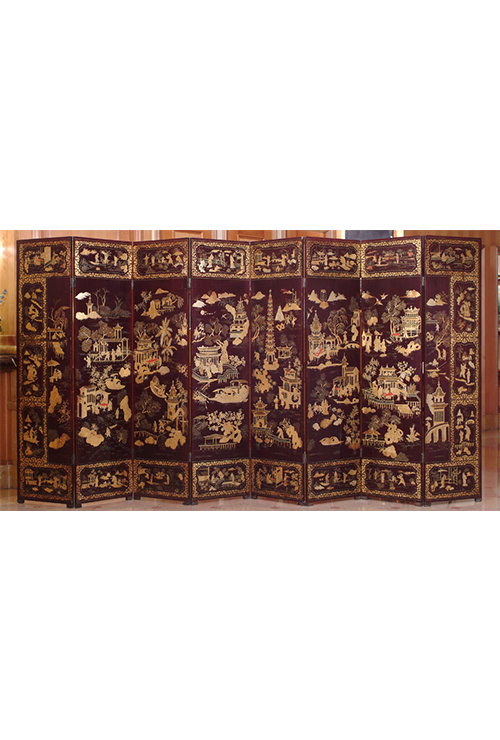
8-Leaves Canton Lacquer Screen of a Palace Scenery
8-Leaves Canton Lacquer Screen of a Palace Scenery
-
Author:UnknownType of work:Furniture
-
Source of Artwork:EasternExhibition Inside the Hotel:Lobby
-
Value:
On the eight-fold sreen are golden flowers. The folding screen is composed of four parts – pinxin, huanban, qunban and liangjiou. The top is huanban which has drawings of historical legends. The middle part, which is the largest part, is pinxin which has drawings of an emperor’s travels around his palaces, literati, gentlemen, ladies and other figures of some towers. On the other side of the screen are carved luscious flowers such as flowers from all seasons, peonies, chrysanthemums, plum blossoms etc. In this piece of work, the levels of thickness of spreading gold lacquer are used to highlight the drawing’s layers; a blank space is used to achieve compositional perspective. Thus the individual theme contents can cross the limits of space and time beyond vision. It seems as if one is traveling in a dreamworld. What catches people’s eyes the most is the red-spotted decoration. This is a representative work of the style combining narrative nature and decorative nature. -
-
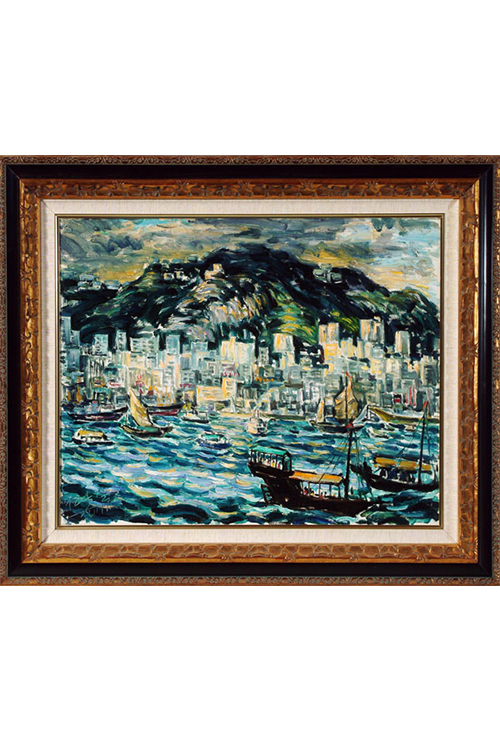
Ancient Bridge
Ancient Bridge
-
Author:Wu Bu-yunType of work:Painting
-
Source of Artwork:EasternExhibition Inside the Hotel:Lobby
-
Value:
Coming from Guangdong Provience, Wu Bu-yun is specialized in Western oil paintings. The only one objective of painting for him is: when looking at his paintings, audiences can immediately recognize that these paintings are made by a Chinese. What he has shown us is oil paintings with Chinese charactersitics and ethnic meaning. Having travelled everywhere, Wu Bu-yun has made efforts towards multiculturalism. At an early age when he lived in Hong Kong, he adopted realism to depict life in Hong Kong society. Soon, he also travelled all over the famous mountains and great rivers of China. Portraying magnificent landscapes, his paintings were filled with strong and lively atmospheres. Later, he settled down in Canada. Lakes, mountains and other sceneries, varying with the four seasons in Canada, are all beautifully presented in his works. His brushwork is short and quick. Thus, his works look rather like Chinese river-and-mountain landscapes. His oil paintings have great variety. In the use of oil paint, he was much concerned to understand the nature of colours. In matching colours, after various colours are blended, a bright-coloured appearance still remains -
-
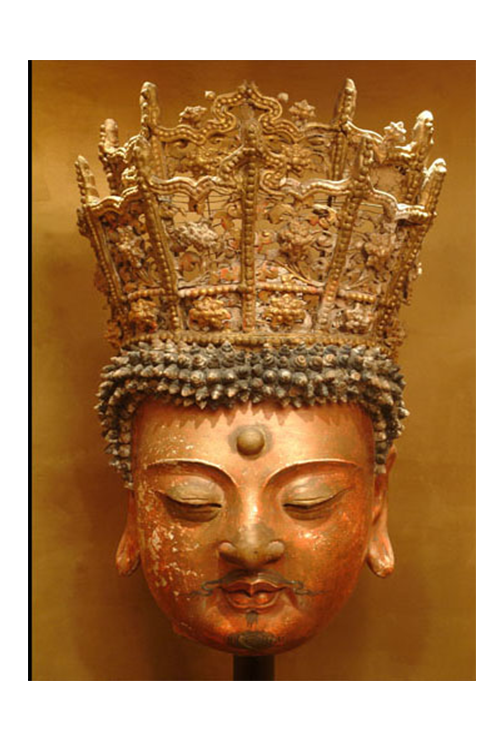
Eastern Shanxi Clay Sculpted Head of Buddha
Eastern Shanxi Clay Sculpted Head of Buddha
-
Author:UnknownType of work:Carving
-
Source of Artwork:EasternExhibition Inside the Hotel:9F
-
Value:
Most parts of Shanxi Province have a temperate monsoon continental climate. This special climate is suitable to develop clay sculpture. In the process of making clay sculpture, it takes at least one year to dry it thoroughly in the wind. After being dried, the clay sculpture can be covered with paper or coloured drawings. Clay sculptures present realism. Although they have religious meaning, human figures’ postures, expressions and clothes are secularized. In the middle of the Buddha’s forehead is one spot called baihao. Its eye look downwards, implying delivering and saving all beings. Statues of Buddha had been created before Tang dynasty whereas theme of religious stories had been focused on only after the Song dynasty. For the Chinese, stone carving was a foreign technique. Stone material in Dunhuang was a conglomerate. When statues could not be made by this material, local clay sculpture technique was used to make up any deficit. China’s earliest clay sculptured Buddha statues were produced in this way. -
-
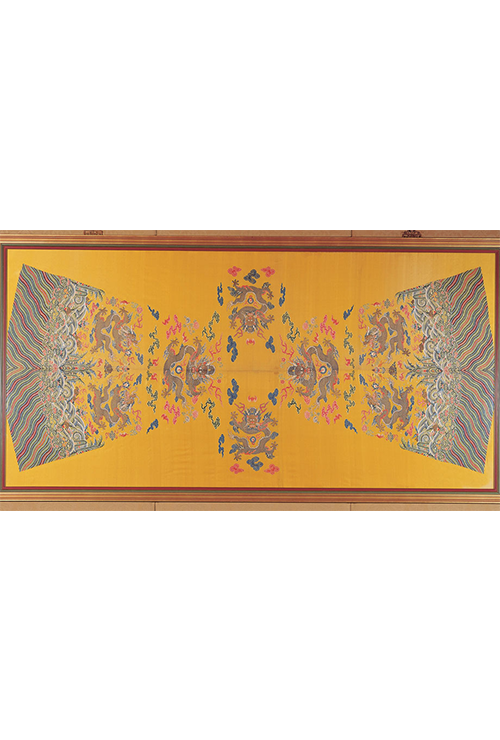
Imperial
Imperial
-
Author:ImperialType of work:Textiles
-
Source of Artwork:Eastern
-
Value:
The imperial robe’s material is of silks and satins. Despite being unfinished, the robe has shows its embryonic form. [The origin of imperial dragon robes] In reign of East Han’s Emperor Ming (59 A.D.), long robes became the official costume. Since then, long robes were a general style for official clothes for many years. The term “imperial dragon robe” (lungpao) started being used in the Qing Dynasty. The dragon was regrded as a symbol of the son of heaven. On the robe are many patterns of dragons. [Making imperial dragon robes] These imperial robes were elaborately and attentively designed by the Qing Dynasty’s top designers in Ruyi House which is today’s Huafangzhai (literal meaning: ‘picturesque boat house’) of Beihai Park. Next, the imperial robe needed to be examined and permitted by the emperors. Then, special messengers delivered the design drafts to manufacturers in Nanking, Soochow or Hangchow to consider the involved materials and techniques and supervise and measure every step of making the imperial robes. [Characteristics of the imperial dragon robe] The bright yellow-coloured robe has collars and sleeves. After the Qing Dynasty, the robe sleeves became smaller. Emperors are regarded as the highest nobility. Thus their robes are decorated with the patterns of nine gold dragons: dragons were on the chest, back, right sleeve, left sleeve, four junctions of two fronts and two backs and inside the robe. Viewed from the imperial robe’s front and back sides, the nine dragons can be seen. The emperors’ highest nobility was thus clearly visible. -
-
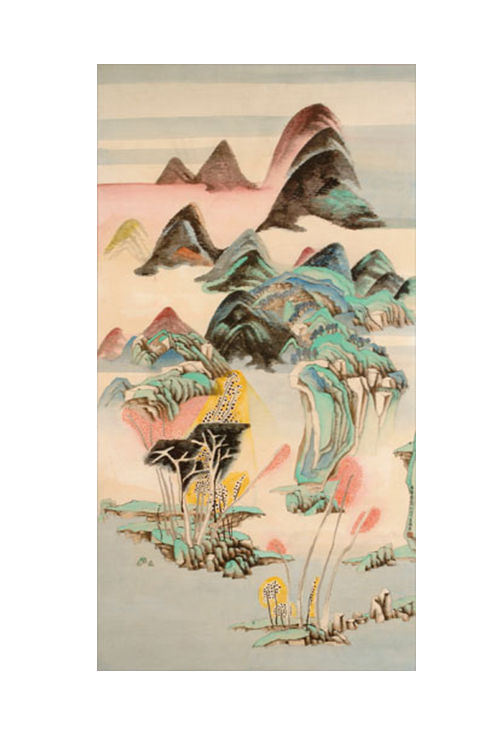
五華聳聚
五華聳聚
-
Author:Yuan ZhanType of work:Painting
-
Source of Artwork:Eastern
-
Value:
Combining traditional and modern ideas, Yuan Zhan’s paintings give audiences room for imagination. A panoramic-view structure and numerous mountains’ overlapping layers lead to an epic-like imposing manner in these paintings. The essence of traditional ink and water paintings is the spritual connotation with which Yuan Zhan is the most familiar as well having his important basic foundation as a painter. Yuan also brings in European “|modernist” art thinking of the early 20th century. The combination of the occidental and oriental elements makes his paintings present unique spatial structure and subjective imagery. Yuan Zhan’s landscape paintings help audiences to enter nature and also to travel in abstract and colourful dream-like mountains and forests by following his painterly logic. Audiences will also be charmed by his novel colourful world of boundless imagination. -
-
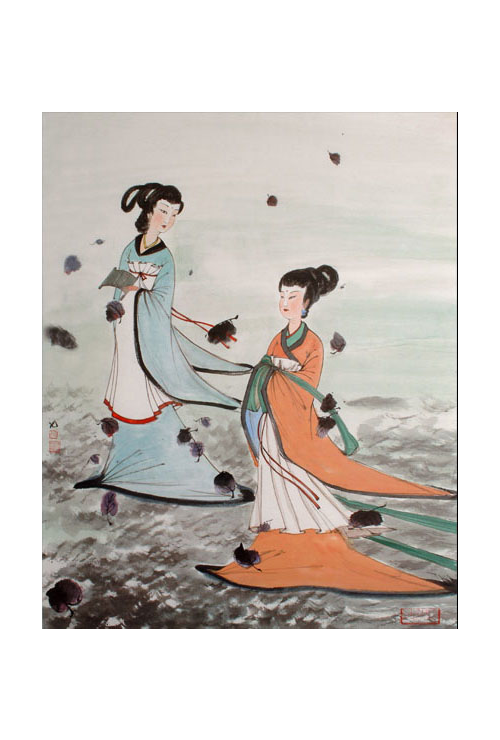
Portrait of Two Xiang Ladies
Portrait of Two Xiang Ladies
-
Author:Fu Yi-yaoType of work:Painting
-
Source of Artwork:Eastern
-
Value:
[Story of the two Xiang ladies] Two ladies called Erhuang and Nuying, who were the daughters of the legendary Yao were married to Shun. The former, who was the elder sister, was the first wife and was called Jun after marriage; the latter one was the second wife and became called Furen. At one time, Shun made an imperial inspection tour in the south of the country. Unfortunately, he died in Cangwu Mountain. Hearing the news, the two ladies wept bitterly. Owing to their deep pain and thinking about the late husband, soon they died in Xian River. Their bodies were buried in Dongting Mountain. It is said that they both became goddesses of Xian River. As a Chinese-painting artist who had stayed in Japan, Fu Yi-yao has won a great reputation in Japan. She is also a daughter of the celebrated Chinese painter Fu Bao-shi. Her main painting achievement is demonstrated in Japanese folk worshipping composition paintings and in a series of large-sized mural paintings of stories about Buddhism. She often uses a Japanese woodcut technique in her works and also retains the style of Chinese ink-and-water paintings. -
-
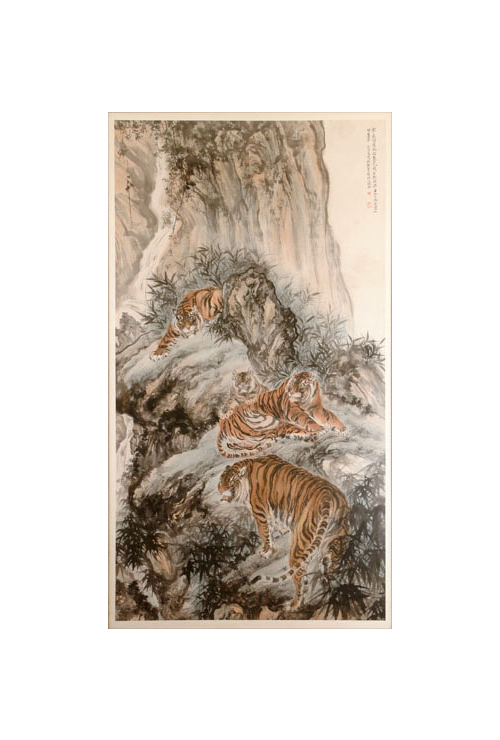
1901-2000AD
Four Tigers in a Tranquil Mountain Streem
-
Author:Zhang Shan-ziType of work:Painting
-
Source of Artwork:EasternExhibition Inside the Hotel:10F
-
Value:
This painter’s name is Ze, his formal name is Shan-zi and his self-chosen name is Lu-chi. He comes from Sichuan, China. He is Zhang Da-qian’s elder brother. Zhang Shan-zi and his younger brother Da-qian have different personalities: Shan-zi was concerned about his country and people and thus won a reputation as a patriotic painter whereas Da-qian was optimistic and straightward and was never concerned about politics. In painting, Da-qian was good at painting flowers. Shan-zi mastered painting animals, especially tigers. Feeding tigers in order to paint them, he is regarded as the most famous Chinese painter of tigers since the Ming Dynasty. In this picture, four tigers have their various expressions and have eyes with a piercing gleam and strong spirit. The tigers’ hairs are fine and delicately drawn. The mountain scenery is brilliantly arranged. The tigers’ stripes are strongly and magnificently painted. His special ways involve delicate lines, a strong spirit and smooth movements – which make the tigers seem so real, their stripes brilliant, and their postures so energetic and agile. There are also clouds and mists winding up into the mounatains all over the painting, resulting in a charming appearance. All the above fully present the painter’s inner style. -


